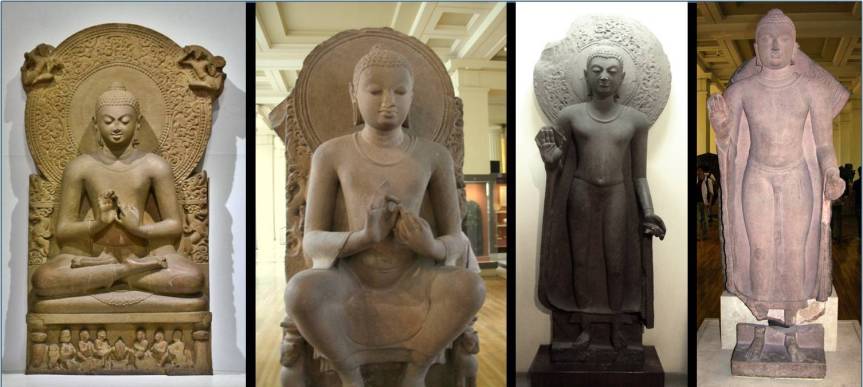Gupta period, beginning of the Classical Period (ca. 320 C.E. – ca. 550 C.E.).
The Amaravati art disappeared as a result of the political and military pressure exercised on the Andhra kings by the Gupta dynasty. The Gupta dynasty had been founded in the north of India around the year 320 and had managed to seize the former imperial capital of the Kushan. It lasted until the year 650 and this period is commonly identified with the classical period of Indian art. With the Gupta dynasty, the Hindu culture reached its peak. The visual arts and literature written in Sanskrit reached a great height; to this period belong collections of lyric poetry and fables that have influenced the Muslim world (many narrations of “The Thousand and One Nights” have Hindu origin) as well as the Western world (Chaucer, Boccaccio, La Fontaine). The great literary jewel of this period is the play “Shakuntala”, written by Kālidāsa, the greatest dramatist and poet of India, who has so deeply impressed and influenced Europeans including Goethe.
The art of the Gupta period continued the production of “rock architecture“, but its most original contribution was the first works of “built architecture” in India, which will be discussed later.

Among the many works of the Gupta “rock architecture”, it must be mention the oldest Buddhist caves found in the rock of Ellora, east of Bombay, and above all, the caves of Ajanta carved between the 5th to 7th centuries, and that include several masterpieces of sculpture and painting that count among the most admirable artistic treasures of humanity. In terms of sculpture, the most famous grottos of Ajanta are the Chaityas 19 and 26, which are full of fine and elegant human figures, in which is frequently observed the triple flexion that gives a different inclination to their heads, chests, and legs. This is an image that recalls the sinuous silhouette of the Greek sculptures of Praxiteles, and it is called the tribhanga* position in the classical treatises of Hindu aesthetics. But above all Ajanta is famous for its mural paintings, whose best examples are perhaps those found in the viharas 1 and 17. In the first one is the famous “Bodhisattva of the blue lotus”, whose attitude and facial expression, with half-closed eyes, reflects a great spiritual calm and a sad compassion full of pity towards all the pain and misery of the world. In the same vihara 1 are paintings with a battle of buffalos, a parade led by a prince mounted on his elephant, various court scenes in which playful groups of dancers appear, etc. From the point of view of the Western tradition, the most baffling is the mixture of both sensuality and asceticism typical of the Gupta art. All male and female bodies are young and bathed in an erotic atmosphere that leads them to tenderly bend over each other. The women, always smiling, show the typical swaying of the tribhanga position, which enhances the shape of hips and breasts, and their naked bodies are lavishly covered with jewels like the yakshi of Sanchi and Bharhut. But this naturalism is imbued with a religious resonance and all those creatures full of grace participate in the mystical fervor of Buddhism, so close to the Franciscan spirituality.


The maximum expression of this religiosity are the figures of the Buddha created in Sarnath during the Gupta period. In them, the human form is idealized to the maximum. The folds of the monk’s cloak and the transparent drapery of the previous Greco-Buddhist images completely disappeared. Only a slight relief around the neck and the curve of the lower edge mark the monastic cloth of the Buddha. The frontality of the images is absolute. His half-closed eyes and lips that barely imply a smile express a serenity full of inner joy for the gift of himself that is the ideal of Buddhism.

As it has been said, under the Gupta dynasty appeared the first buildings of a proper “built architecture” not completely carved into the rock. The oldest ones are the cylindrical stupa of Dhamek, in Sarnath, and the imposing sanctuary of Bodh-Gaya erected in Bihar in the 4th century in the same place where the Buddha obtained “enlightenment”. But the development of this “built architecture” was due, above all, to the fact that from the end of the 6th century and the beginning of the 7th the old Brahmanism* began to replace Buddhism. The Gupta emperors, by protecting neo-Brahmanism, precipitated the decline of Buddhism in India and its subsequent demise. The Neo-Brahmanic cult needed a type of temple in which the sanctuary, where the Brahmin* officiated, needed to be separated and isolated from the mass of the faithful. This forced the architects to look for new constructive formulas, since the Buddhist chaitya was not suitable for the practice of this new liturgy. After many trials and hesitations, the Brahmanic architecture ended up being divided according to two great types of temples called, because of their geographical distribution, Northern or Indo-European or Nagara style and Southern or Dravidian style.

The most characteristic of the Indo-European style from the north is the square-shaped sanctuary whose high roof rises like a tower that in turn curves towards its top. This curvilinear tower is called shikhara*. Its crowning forms a kind of crushed cushion with vertical grooves that reproduces the sacred Amalaki fruit (also known as Emblic or Indian gooseberry: Phyllanthus emblica – botanical family Phyllanthaceae). Probably the oldest example of shikhara is the temple of Lakshmana, in Sirpur, a small town now lost in the jungle but that during the 7th century was a great capital.

__________
 Tribhanga: Or Tribunga is a (tri-bent pose) standing body position used in the traditional Indian sculpture, art and Indian classical dance forms. As compared with the contrapposto pose Tribhanga, literally meaning three parts break, consists of three bends in the body; at the neck, waist and knee, hence the body is oppositely curved at waist and neck which gives it a gentle “S” shape and is considered the most graceful and sensual of the dance positions. It has been closely associated with the Hindu deity Krishna who is often portrayed in this posture.
Tribhanga: Or Tribunga is a (tri-bent pose) standing body position used in the traditional Indian sculpture, art and Indian classical dance forms. As compared with the contrapposto pose Tribhanga, literally meaning three parts break, consists of three bends in the body; at the neck, waist and knee, hence the body is oppositely curved at waist and neck which gives it a gentle “S” shape and is considered the most graceful and sensual of the dance positions. It has been closely associated with the Hindu deity Krishna who is often portrayed in this posture.
Brahmanism: (also known as The Historic Vedism Religion, Vedism, Vedic Brahmanism, and ancient Hinduism). It was the religion of the Indo-Aryans of northern India during the Vedic period. It is one of the historical elements from which modern Hinduism emerged. The Vedic liturgy is conserved in the mantra portion of the four Vedas, which are compiled in Sanskrit. The religious practices centered on a clergy administering rites.
Brahmin: A class or caste in Hinduism specialising as priests, teachers (acharya) and protectors of sacred learning across generations. The traditional occupation of Brahmins was that of priesthood at the Hindu temples or at socio-religious ceremonies and rite of passage rituals.
 Shikhara: (from the Sanskrit meaning “mountain peak”). It refers to the rising tower in the Hindu temple architecture of North India, and also often used in Jain temples. A shikhara over the garbhagriha chamber where the presiding deity is enshrined is the most prominent and visible part of a Hindu temple of North India. In South India, the equivalent term is vimana; unlike the shikhara, this refers to the whole building, including the sanctum beneath.
Shikhara: (from the Sanskrit meaning “mountain peak”). It refers to the rising tower in the Hindu temple architecture of North India, and also often used in Jain temples. A shikhara over the garbhagriha chamber where the presiding deity is enshrined is the most prominent and visible part of a Hindu temple of North India. In South India, the equivalent term is vimana; unlike the shikhara, this refers to the whole building, including the sanctum beneath.
 Vishnu: One of the principal deities of Hinduism. Vishnu is the “preserver” in the Hindu trinity (Trimurti) that includes Brahma and Shiva. In Vaishnavism, Vishnu is identical to the formless metaphysical concept called Brahman, the supreme, who takes various avatars as “the preserver, protector” whenever the world is threatened with evil, chaos, and destructive forces. His avatars most notably include Rama in the Ramayana and Krishna in the Mahabharata. In Hindu iconography, Vishnu is usually depicted as having a dark, or pale blue complexion and having four arms. He holds a padma (lotus flower) in his lower left hand, Kaumodaki gada (mace) in his lower right hand, Panchajanya shankha (conch) in his upper left hand and the Sudarshana Chakra (discus) in his upper right hand. A traditional depiction is Vishnu reclining on the coils of the serpent Shesha, accompanied by his consort Lakshmi, as he “dreams the universe into reality”.
Vishnu: One of the principal deities of Hinduism. Vishnu is the “preserver” in the Hindu trinity (Trimurti) that includes Brahma and Shiva. In Vaishnavism, Vishnu is identical to the formless metaphysical concept called Brahman, the supreme, who takes various avatars as “the preserver, protector” whenever the world is threatened with evil, chaos, and destructive forces. His avatars most notably include Rama in the Ramayana and Krishna in the Mahabharata. In Hindu iconography, Vishnu is usually depicted as having a dark, or pale blue complexion and having four arms. He holds a padma (lotus flower) in his lower left hand, Kaumodaki gada (mace) in his lower right hand, Panchajanya shankha (conch) in his upper left hand and the Sudarshana Chakra (discus) in his upper right hand. A traditional depiction is Vishnu reclining on the coils of the serpent Shesha, accompanied by his consort Lakshmi, as he “dreams the universe into reality”.
